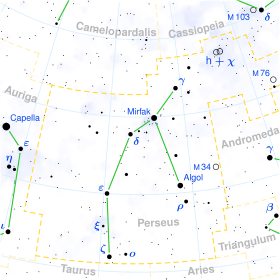Pi Persei
| Observation data Epoch J2000 Equinox J2000 | |
|---|---|
| Constellation | Perseus |
| Right ascension | 02h 58m 45.66985s[1] |
| Declination | 39° 39′ 45.8141″[1] |
| Apparent magnitude (V) | 4.70[2] |
| Characteristics | |
| Spectral type | A2Vn[3] |
| U−B color index | +0.12[2] |
| B−V color index | +0.06[2] |
| Astrometry | |
| Radial velocity (Rv) | +14.20[4] km/s |
| Proper motion (μ) | RA: +25.65[1] mas/yr Dec.: -41.62[1] mas/yr |
| Parallax (π) | 10.53 ± 0.28[1] mas |
| Distance | 310 ± 8 ly (95 ± 3 pc) |
| Absolute magnitude (MV) | -0.21[5] |
| Details | |
| Mass | 3.02[6] M☉ |
| Radius | 4.8[7] R☉ |
| Luminosity | 170[6] L☉ |
| Surface gravity (log g) | 3.53[8] cgs |
| Temperature | 9,290[6] K |
| Rotational velocity (v sin i) | 186[6] km/s |
| Other designations | |
| Database references | |
| SIMBAD | data |
Pi Persei (π Per) is a star in the constellation Perseus. It also has the traditional name Gorgonea Secunda.
Pi Persei has an apparent magnitude of +4.7[2] and spectral class A2V.[3] The star is about 310 light years from Earth.[1]
In Chinese astronomy, Gorgonea Secunda is called 積屍, Pinyin: Jīshī, meaning Heap of Corpses, because this star is marking itself and stand alone in Heap of Corpses asterism, Stomach mansion (see : Chinese constellation).[10] 積屍 (Jīshī), westernized into Tseih She, and the meaning is "the Piled-up Corpses". R.H. Allen misidentified Tseih She as β Persei (Algol).[11]
References
- 1 2 3 4 5 6 Van Leeuwen, F. (2007). "Validation of the new Hipparcos reduction". Astronomy and Astrophysics. 474 (2): 653. arXiv:0708.1752. Bibcode:2007A&A...474..653V. doi:10.1051/0004-6361:20078357. Vizier catalog entry
- 1 2 3 4 Ducati, J. R. (2002). "VizieR Online Data Catalog: Catalogue of Stellar Photometry in Johnson's 11-color system". CDS/ADC Collection of Electronic Catalogues. 2237. Bibcode:2002yCat.2237....0D.
- 1 2 Hoffleit, D.; Warren, W. H. (1995). "VizieR Online Data Catalog: Bright Star Catalogue, 5th Revised Ed. (Hoffleit+, 1991)". VizieR On-line Data Catalog: V/50. Originally published in: 1964BS....C......0H. 5050. Bibcode:1995yCat.5050....0H.
- ↑ Wilson, R. E. (1953). General Catalogue of Stellar Radial Velocities. Carnegie Institution for Science. Bibcode:1953GCRV..C......0W. LCCN 54001336.
- ↑ Anderson, E.; Francis, Ch. (2012). "XHIP: An extended hipparcos compilation". Astronomy Letters. 38 (5): 331. arXiv:1108.4971. Bibcode:2012AstL...38..331A. doi:10.1134/S1063773712050015. Vizier catalog entry
- 1 2 3 4 Zorec, J.; Royer, F. (2012). "Rotational velocities of A-type stars". Astronomy & Astrophysics. 537: A120. arXiv:1201.2052. Bibcode:2012A&A...537A.120Z. doi:10.1051/0004-6361/201117691. Vizier catalog entry
- ↑ Allende Prieto, C.; Lambert, D. L. (1999). "Fundamental parameters of nearby stars from the comparison with evolutionary calculations: Masses, radii and effective temperatures". Astronomy and Astrophysics. 352: 555. arXiv:astro-ph/9911002. Bibcode:1999A&A...352..555A. Vizier catalog entry
- ↑ David, Trevor J.; Hillenbrand, Lynne A. (2015). "The Ages of Early-Type Stars: Strömgren Photometric Methods Calibrated, Validated, Tested, and Applied to Hosts and Prospective Hosts of Directly Imaged Exoplanets". The Astrophysical Journal. 804 (2): 146. arXiv:1501.03154. Bibcode:2015ApJ...804..146D. doi:10.1088/0004-637X/804/2/146. Vizier catalog entry
- ↑ Richard Hinckley Allen (1899). Star-names and Their Meanings. G.E. Stechert. pp. 334–.
- ↑ (in Chinese) AEEA (Activities of Exhibition and Education in Astronomy) 天文教育資訊網 2006 年 7 月 11 日
- ↑ Richard Hinckley Allen: Star Names — Their Lore and Meaning: Perseus
This article is issued from
Wikipedia.
The text is licensed under Creative Commons - Attribution - Sharealike.
Additional terms may apply for the media files.
